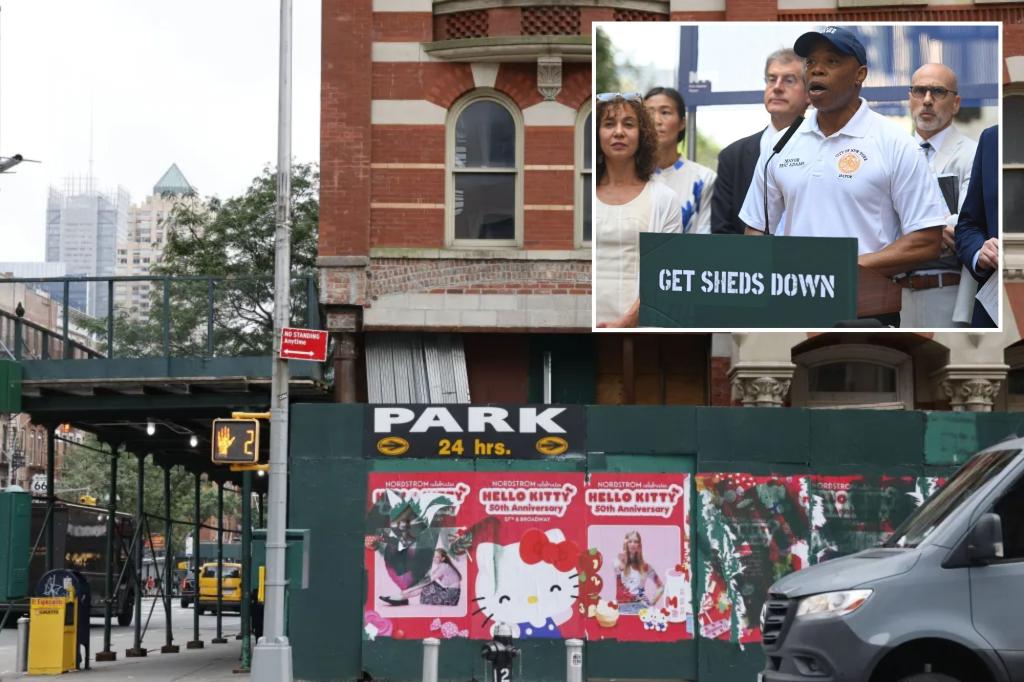Sorry, Mayor Adams: Business-wrecking “sidewalk sheds” won’t come down until City Hall finds the guts to change the laws that spawned them, and Department of Buildings rules that make them worse.
Incidental tweaks to the laws now being considered won’t make a dent.
It’s a lie to blame the scourge on a few unscrupulous landlords who keep the eyesores up longer than they should.
It’s also untrue that Big Apple buildings are uniquely decrepit, needing rigid oversight to prevent citizens from falling under a cascade of loose masonry, bricks and steel.
At last week’s mayoral press conference, Adams trumpeted a new study that found a light-killing, vagrant-harboring sidewalk shed can cost a business $100,000 a year in lost revenue.
Gee, who would have guessed it?
But he only suggested meaningless non-solutions, like asking the City Council to allow drones to speed up inspections.
Sillier still, he may push the Buildings Department to end a requirement that sheds be painted dark green.
If he got out of the house more, he’d see that many sheds are already painted white, blue and red — like the monster around Carnegie Hall.

No, Manhattan looks like a shabby, bombed-out wreck for one reason only: Because elected officials are too chicken to tangle with the opaque scaffold-rental industry, which rakes in an estimated $1 billion every year from the sheds.
Besides enriching the companies that rent them, the business also draws legions of well-paid consultants, inspectors, architects and engineers to the trough.
Puny fines for errant landlords won’t bring our sidewalks back from the scourge of what most people call scaffolds.
Adams and his commissioners complain that landlords keep sheds up too long because it’s more expensive to make façade repairs than to pay city fines for not making those fixes.
But the oft-cited 400-odd sheds that notoriously stand after five years are fewer than 5% of the city’s estimated 9,000 sheds, which all told run an estimated 400 miles in length.
The hypocrisy is beyond infuriating: The city itself owns many buildings where the eyesores have stood for years — such as at the office of the Chief Medical Examiner on First Avenue at East 31st Street.
Adams’ supposed crackdown is a public relations ploy to blunt criticism by disgusted store and restaurant owners and by ordinary New Yorkers who watch in dismay as the dreaded sheds gobble up blocks-on-end of Manhattan.
Why is New York the only American (possibly world) city with enough sidewalk sheds to reach from here to Niagara Falls?
Simple: Facade-inspection laws in Chicago and other large cities are much more rational and flexible than our Local Laws 10 and 11, which date to the early 1980s.
After a single tragic incident when a Columbia University student was killed by falling debris, the city mandated inspections of every building more than six stories tall every five years — irrespective of its age, construction material or likelihood of façade failure.
If inspections turn up any “hazardous” condition, no matter how minor, the Department of Buildings — which is supposed to protect the public, but equally carries water for the scaffold-rental industry — requires sidewalk bridges to be erected until repairs are completed, even though private engineers say simple netting could provide as much protection to pedestrians.
In New York, even a single loose brick found by an inspector forces a required repair and spawns a sidewalk bridge.
The monstrosities even shroud the ground levels of modern office towers made of steel and glass.
But, as the Manhattan Institute’s Connor Harris wrote in 2022, the scaffolding is mostly unnecessary.
New York’s “unique and unusually costly” regulations make “no allowances for building age or materials,” Harris wrote, “even though newer buildings have far lower risk of façade disintegration, and particular materials such as terra cotta pose a much worse danger than others.”
For example, Chicago, which has more large buildings than any US city outside New York, divides buildings into four risk categories. The safest class requires inspections only every 12 years.
Which is why Chicago, for all its well-known problems, is largely shed-free — yet its emergency rooms aren’t overrun by victims of falling brick.
Nor is there a plague of deaths in Cincinnati, which only requires inspections at 12-year intervals.
New Yorkers should see through City Hall’s lies about sidewalk bridges and call the mayor, the Council and the DOB out on it.
Otherwise, there won’t be a single sidewalk left that isn’t shrouded in permanent gloom.
